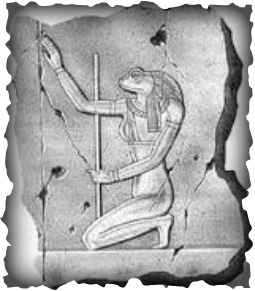Per-Ḥeqat
𓎛𓏘𓏏𓆏 𓋾𓏘𓏏𓆗 𓋾𓏘𓏏𓆇𓁐 𓆏𓏏𓆇 𓋾𓈍𓏏𓆇
𓋾𓏘𓏏𓁐
MDC: Hqt
Gardiner:
Budge: Ḥeqit, Ḥeqet, Ḥeqtit
Alt Egyptian: Ḥqt Ḥqyt, Ḥqtyt
Transliteration: Heket, Heqet
Coptic:
Hebrew:
Greek:
Demotic:
English: Heket
Kemetic: Heqet
IPA: ħaˈqaːtat
Alt: Heqat, Hekit, Heket
Pronounced: Ḥeqat (MK) Ḥaqā́tat (Wiki), Ḥeqtit
Meaning: She the great ruler (from HqAt)
Gardiner:
Budge: Ḥeqit, Ḥeqet, Ḥeqtit
Alt Egyptian: Ḥqt Ḥqyt, Ḥqtyt
Transliteration: Heket, Heqet
Coptic:
Hebrew:
Greek:
Demotic:
English: Heket
Kemetic: Heqet
IPA: ħaˈqaːtat
Alt: Heqat, Hekit, Heket
Pronounced: Ḥeqat (MK) Ḥaqā́tat (Wiki), Ḥeqtit
Meaning: She the great ruler (from HqAt)
Home:
Temple: /Apollinopolis Mikra/ Ἀπόλλωνος ἡ μικρά, Qus/قوص 'Haroeris'
Nome:
Consort
Khnemu (Abydos, Herwer, 16th nome UE Gau/Ma-Hedj )
Sobek
Horu-wer (In form of Hut-Hor/Hathor)
Children
Horu-wer (with Khnemu)
Father
Ra
Mother
Siblings
Alternative Parentage
Priest names
Title of Midwives bAk Heqat / Servants of Heqet
Hm nTr Hqt / Priest
Features
A women with the head of frog
Symbols
Frogs
Corn
Nile flood
Phallus
Shen Ring 𓍶
Roles
Goddess of fertility, child birth final stages, and grain germination. She also was known for helping Khenmu on the potters wheel a kind of midwife role. Women often wore frog amulets representing Heqat during childbirth. She is also known ad the goddess of resurrection in connection with helping Auset with birthing Horu and her husband Wesir/Osiris coming back to life to impregnate Auset.
Connection to other gods
Hut-Hor/ Hathor
Auset/ Isis
Khnemu
Meshkhenet
Hecate/ Ἑκάτη (Possibly inspired this god)
Celebrations
IV. Shomu 4
Khoiak festival
Offering items
Frog fetish
Cedar
Lavender
Sandalwood
Blue lotus
Papyrus
Water
Beer
Protects
Women In childbirth wore a frog fetish representing Heqat siting on a lotus amulet with Greek words inscribed on the bottom and is to be worn in childbirth.
Έγω εἰμι Ἁναστάσις
I am the resurrected
Egyptian equivalent)
𓇋𓏌𓎡 𓄙𓋹
anuk wHm anx
ref. The Gods of the Egyptian Vol. II by E.A. Wallis Budge
Ivory knives and clappers were inscribed with her name to ward of Evil
Other names
Epitaphs
dwAt wrt-- greta one of the Duat
nbt pt-- lady of the sky
qmA-- creator
She who hastens the birth
Breath of life
Hmt-Hr-wr? /Mistress of the City of Herwer (16th nome UE Gau/Ma-Hedj)
Ref. http://wepwawet.org/wiki/index.php?title=Heqet, https://en.wikipedia.org/wiki/Heqet
Temple: /Apollinopolis Mikra/ Ἀπόλλωνος ἡ μικρά, Qus/قوص 'Haroeris'
Nome:
Consort
Khnemu (Abydos, Herwer, 16th nome UE Gau/Ma-Hedj )
Sobek
Horu-wer (In form of Hut-Hor/Hathor)
Children
Horu-wer (with Khnemu)
Father
Ra
Mother
Siblings
Alternative Parentage
Priest names
Title of Midwives bAk Heqat / Servants of Heqet
Hm nTr Hqt / Priest
Features
A women with the head of frog
Symbols
Frogs
Corn
Nile flood
Phallus
Shen Ring 𓍶
Roles
Goddess of fertility, child birth final stages, and grain germination. She also was known for helping Khenmu on the potters wheel a kind of midwife role. Women often wore frog amulets representing Heqat during childbirth. She is also known ad the goddess of resurrection in connection with helping Auset with birthing Horu and her husband Wesir/Osiris coming back to life to impregnate Auset.
Connection to other gods
Hut-Hor/ Hathor
Auset/ Isis
Khnemu
Meshkhenet
Hecate/ Ἑκάτη (Possibly inspired this god)
Celebrations
IV. Shomu 4
Khoiak festival
Offering items
Frog fetish
Cedar
Lavender
Sandalwood
Blue lotus
Papyrus
Water
Beer
Protects
Women In childbirth wore a frog fetish representing Heqat siting on a lotus amulet with Greek words inscribed on the bottom and is to be worn in childbirth.
Έγω εἰμι Ἁναστάσις
I am the resurrected
Egyptian equivalent)
𓇋𓏌𓎡 𓄙𓋹
anuk wHm anx
ref. The Gods of the Egyptian Vol. II by E.A. Wallis Budge
Ivory knives and clappers were inscribed with her name to ward of Evil
Other names
Epitaphs
dwAt wrt-- greta one of the Duat
nbt pt-- lady of the sky
qmA-- creator
She who hastens the birth
Breath of life
Hmt-Hr-wr? /Mistress of the City of Herwer (16th nome UE Gau/Ma-Hedj)
Ref. http://wepwawet.org/wiki/index.php?title=Heqet, https://en.wikipedia.org/wiki/Heqet
Invocations to Heqat
Now when I was before this goddess,
Heqet, lady of Herwer,
At her beautiful feast of the year's last month,
I being controller of Thoth,
She went to a spot in the north of this town,
To "House of Heqet," as it is called by all,
Which was ruined since time immemorial.
The water had carried it off every year,
Till its foundation plan was no longer seen,
It only was called "House of Heqet,"
While no brick nor stone was there,
Then the goddess halted there.
I summoned the temple scribe of this goddess,
I gave him silver without counting,
To make a monument there from that day.
I built a great rampart around it,
So that the water could not carry it off.
I was diligent in consulting the scholars,
So as to organise the rites,
By which this goddess is served,
And content her till she knew it was done.
-- Miriam Lichtheim (1980), Ancient Egyptian Literature: Volume III: The Late Period, pp. 47-48
Now when I was before this goddess,
Heqet, lady of Herwer,
At her beautiful feast of the year's last month,
I being controller of Thoth,
She went to a spot in the north of this town,
To "House of Heqet," as it is called by all,
Which was ruined since time immemorial.
The water had carried it off every year,
Till its foundation plan was no longer seen,
It only was called "House of Heqet,"
While no brick nor stone was there,
Then the goddess halted there.
I summoned the temple scribe of this goddess,
I gave him silver without counting,
To make a monument there from that day.
I built a great rampart around it,
So that the water could not carry it off.
I was diligent in consulting the scholars,
So as to organise the rites,
By which this goddess is served,
And content her till she knew it was done.
-- Miriam Lichtheim (1980), Ancient Egyptian Literature: Volume III: The Late Period, pp. 47-48

